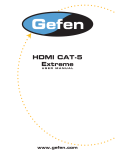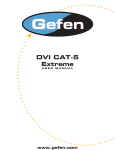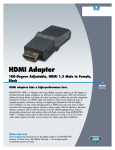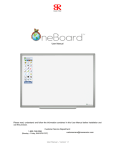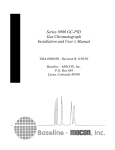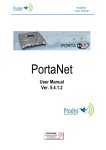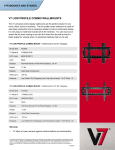Download HDMI CAT-5 MSR EXTREME
Transcript
HDMI CAT-5 MSR EXTREME USER MANUAL www.gefen.com TABLE OF CONTENTS 1 Introduction 2 HDMI CAT-5 Extreme Sender Front Panel Descriptions 3 HDMI CAT-5 MSR Extreme Receiver Front Panel Descriptions 4 How To Connect The HDMI CAT-5 MSR Extreme 5 Dip Switch Usage Guide 6 CAT5 Link Cable - Wiring Diagram 7 Mounting Plate Installation 8 Frequently Asked Questions 9 Terminology 10 Specifications 11 Warranty OPERATION NOTES READ THESE NOTES BEFORE INSTALLING OR OPERATING The HDMI CAT-5 MSR Extreme Extender • The HDMI CAT-5 MSR Extreme is housed in a metal box for better RF shielding. • Your CAT-5 cable should not exceed 200 feet. • If you do not need DDC or HDCP data you can use a single CAT-5 cable for the video only. The DDC will not be connected. (For further information, see our Terminology section on page 9.) If HDCP is required, both CAT-5 cables must be used between the sender and receiver units. • If the source requires EDID present, you can use the Gefen DVI Detective to provide EDID information. * CAT6 cable is suitable for high resolutions at 50 meters. INTRODUCTION The HDMI CAT-5 MSR Extreme sender unit sits next to your computer, DVD player or any set-top box with a HDMI output. The cable supplied with the HDMI CAT-5 MSR Extreme connects your HDMI source to the send unit. The HDMI CAT-5 MSR Extreme receiver unit sits next to your HDMI display - up to 200 feet away. The display plugs into the back of the HDMI CAT-5 MSR Extreme receiver unit. Two CAT-5 cables connect the HDMI CAT-5 Extreme-S and the HDMI CAT-5 MSR Extreme-R units to each other. CONTENTS The HDMI CAT-5 MSR Extreme system consists of: (1) HDMI CAT-5 Extreme-S (1) HDMI CAT-5 MSR Extreme (1) 6 ft HDMI to HDMI Cable M-M (2) HDMI CAT5 Wallmounts (2) 5V DC power supply 1 HDMI CAT-5 EXTREME SENDER FRONT PANEL DESCRIPTIONS Connects to 5 volt power supply HDMI input connects to HDMI source Power Indicator CAT-5 carries TMDS signals CAT-5 carries DDC/HDCP signals 2 HDMI CAT-5 MSR EXTREME RECEIVER FRONT PANEL DESCRIPTIONS Connects to 5 volt power supply Connects to HDMI display EQ trim pod Power Indicator CAT-5 carries DDC/HDCP signals 3 CAT-5 carries TMDS signals HOW TO CONNECT THE HDMI CAT-5 MSR EXTREME 1 Connect your display to the HDMI CAT-5 MSR Extreme receiver unit. 2 Connect your source to the HDMI CAT-5 Extreme sender unit 3 Connect your CAT-5 cables between the sender and the receiver 4 Plug the 5V power supply into the HDMI CAT-5 MSR Extreme sender and receiver unit 5 You should now have picture. If you do not see a picture, try unplugging and replugging the HDMI input on the HDMI sender unit. Make sure your CAT-5 cables are not crossed. Recycle the power on the unit. * If problems persist try adjusting the Dip Switches by following the Dip Switch Usage Guide (refer to page 5). HOW TO USE THE EQ TRIM POT The EQ trim pot is used extensions over 130 ft. By default, the DVI Extreme comes set to "Auto EQ" (with dip switch 1 OFF). Underneath the receiver is a bank of dip switches, hidden by a blank sticker, and if you flip dip switch 1 ON you can turn off the "Auto EQ" so that you can manually EQ your signal by using the EQ trim pot on the receiver. If you flip dip switch number 1 back to the OFF position you can set the DVI Extreme back to "Auto EQ". Auto EQ works best when the sender is set to "NO BOOST" (see page 5). Auto EQ also works best up to 130 ft reliably. If you are using the DVI CAT5 Extreme beyond any distance of 130 ft., then It is best if you manually EQ your signal. USING THE TRIMPOT 1 Have both of your CAT5 or CATs6 cables connected. 2 Start by having the source connected and playing with your display on. 3 Set the sender to medium boost. 4 Start with the trimpot all the way counter clockwise and slowly turn the trim pot clockwise. If you do not get a picture still or have noise, set the sender to high boost and try to reEQ your signal. 4 SERVICE SWITCH USAGE GUIDE The sender unit of the Gefen CAT5 MS Extreme contain a set of service switches (also called dip switches) located underneath the unit. Peeling back the silver sticker on the bottom of the unit will reveal the service switch bay. These service switches are used to boost the signal to best match the conditions in your setup. (*Note: Adjustments should be done with sources and display on. Switches 3 and 4 are not used.) Sender Dip Switch Settings Setting Switch 1 Switch 2 No Boost OFF ON Normal Boost (Default) OFF OFF Strong Boost ON OFF Receiver Dip Switch Settings Setting Switch 1 Switch 2 Manual EQ ON OFF Auto EQ OFF OFF Adjustment Guidelines: 1) Strong boost should not be used on stranded cables. Strong boosting will cause pixels or no picture on these cables. 2) Using the wrong settings will not damage the units; it will either produce no image or a noisy image. 3) To eliminate the possibility of cross talk and interference, cables must be terminated with 568B scheduling. (See page 6 for details) 4) No Boost should be set when using Auto EQ. 5 6 1 8 8 7 6 5 4 3 2 1 RJ-45 Jack Brown White/Brown Green White/Blue Blue White/Green Orange White/Orange 8 7 6 5 4 3 2 1 1 8 RJ-45 Jack CAT5 LINK CABLE - WIRING DIAGRAM MOUNTING PLATE INSTALLATION 7 TROUBLESHOOTING Frequently Asked Questions What kind of CAT-5e cable should I be using? Solid core CAT-5e cable rated at 350 Mhz and terminated in 568a or 568b is the minimum requirement. For resolutions greater than 1280x1024 or 1080i, Gefen recommends solid CAT-6 cables. I’m getting no video on the screens, what can I check? First thing to check is make sure that the video CAT5 is linked to the other video CAT5 port and the same with the DDC ports. Try removing the power supply from the receiver side, if the power light turns off then you have your CAT-5 cables crossed. In some setups with grounding issues you will not get a picture with the receiver powered. Test to make sure the units are working with short CAT-5e cables 15-20 feet. You can also make sure you have the correct boost setting configured (refer to page 5). Occasionally the picture blanks out, how do I fix this? Flickering or a blinking image is the result of a loss of sync between the display and the source. Try lowering the resolution to see if that helps, if it does, the CAT-5 cables you are using are unable to handle the bandwidth of the higher resolution and thus you are losing sync. Try a shielded CAT-6 cable on the video line to reduce interference. Usually this is caused by EMI and a shielded CAT-6 with metal RJ-45 connectors with the drain wire soldered to the connectors will resolve the issue. You can also try adjusting the service switches. Please refer to the service switch guide on page 5 for the different combinations. Why is there a green or pink tint to my picture? A tint of green or pink in the picture is a result of incorrect colorspace being transmitted. This can be resolved by recycling power on your devices including the extender. If this does not help, the DDC data containing the colorspace is not being transmitted correctly due to loss in the CAT5 cable, try replacing the DDC cable. 8 TERMINOLOGY CAT-5 Category 5 cable, commonly known as Cat 5, is an unshielded twisted pair type cable designed for high signal integrity. The actual standard defines specific electrical properties of the wire, but it is most commonly known as being rated for its Ethernet capability of 100 Mbit/s. Its specific standard designation is EIA/TIA-568. Cat 5 cable typically has three twists per inch of each twisted pair of 24 gauge copper wires within the cable. CAT-5e Similar to Cat 5 cable, but is enhanced to support speeds of up to 1000 megabits per second. DDC Short form for Display Data Channel. It is a VESA standard for communication between a monitor and a video adapter. Using DDC, a monitor can inform the video card about its properties, such as maximum resolution and color depth. The video card can then use this information to ensure that the user is presented with valid options for configuring the display. DDWG Digital Display Working Group DDWG are the creators of the HDMI specification. HDMI The High-Definition Multi-media Interface (HDMI) is an industry-supported, uncompressed, all-digital audio/video interface. HDMI provides an interface between any compatible digital audio/video source, such as a set-top box, DVD player, and A/V receiver and a compatible digital audio and/or video monitor, such as a digital television (DTV). HDCP High-Bandwidth Digital Content Protection. Created by Intel, HDCP is used with HDTV signals over HDMI and HDMI connections and on D-Theater D-VHS recordings to prevent unauthorized duplication of copy written material. HDTV High-Definition Television. The high-resolution subset of our DTV system. The ATSC defines HDTV as a 16:9 image with twice the horizontal and vertical resolution of our existing system, accompanied by 5.1 channels of Dolby Digital audio. The CEA defines HDTV as an image with 720 progressive or 1080 interlaced active (top to bottom) scan lines. 1280:720p and 1920:1080i are typically accepted as high-definition scan rates. VESA Video Electronic Standards Association, a consortium of manufacturers formed to establish and maintain industry wide standards for video cards and monitors. VESA was instrumental in the introduction of the Super VGA and Extended VGA video graphics standards with a refresh rate of 70 Hz, minimizing flicker and helping to reduce user eyestrain and fatigue. 9 SPECIFICATIONS Video Amplifier Bandwidth ................................................................................ 1.65 Gbps Input Video Signal ......................................................................................... 1.2 volts p-p Input DDC Signal .................................................................................... 5 volts p-p (TTL) Single Link Range .............................................................................1080p / 1920 x 1200 HDMI Connector Type ..................................................................... Type A 19 pin female Link Connector ........................................................................................................ RJ-45 Power Consumption .................................................................................. 20 watts (max) Power Supply ......................................................................................................... 5V DC Dimensions ............................................................................. 3.4” W x 1.25” H x 3.25” D Shipping Weight ....................................................................................................... 3 lbs. 10
















